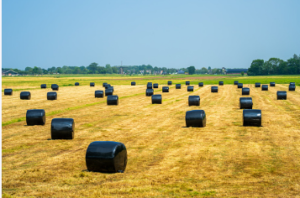Silage wrap, the best way to protect hay and straw bales, is an effective way to maintain their quality and nutritional value. Not only does this keep them fresh for later use, but it can also save money on feeding animals during cold weather by keeping them available for later consumption.
 Durability
Durability
Silage wrap is a plastic film used to wrap bales of hay or straw to protect them from moisture, insects and other external elements. It helps preserve the quality and nutrients in the feed until it can be utilised later.
Silage wrap offers several advantages over other bale wrap materials, including its durability and resistance to abrasion, tackiness and puncture. Furthermore, it’s non-toxic and odourless – meaning there are no risks for animals or the environment when used correctly.
It makes it an ideal option for storing and protecting hay or straw from external elements, particularly helpful to farmers who may not have sufficient storage space to store their bales. Furthermore, keeping them cool helps maintain their quality and nutrients.
Another advantage of bale wrap is that it helps minimise degradation during storage and feeding, benefiting your farm and the animals fed on it.
Store wrapped bales on gravel to prevent leaks and keep vermin away, as they can be attracted to silage and cause damage.
Silage wrap is not only durable and cost-effective, but it is also easy to use and transport. Being so light and portable makes it a perfect choice for farmers who need to transport it for their farms.
Tackiness
When bale wrap, it is essential to cover it with silage wrap to protect against loss. This preservation method can save farmers up to a third of their product!
Wrapping hay for cows has the primary advantage of keeping out oxygen. Lacking oxygen helps break down lactic bacteria in the hay, making it easier for animals to digest and reducing the amount of feed you need to give them. It also reduces waste generated from livestock operations.
Silage wrap helps seal the bale tightly, keeping out leaks. A secure seal is essential for creating an extensive and quality bale – so make sure you buy the correct wrap for your application!
High-quality products should have the ideal amount of tack, helping keep plastic from peeling away. Plus, some higher-end brands have built-in UV protection, so you don’t have to worry about your hay being exposed to damaging UV rays.
Silage wrap is pre-stretched, making applying the bale much faster without extra time or labour. Most farms use silage wrap that you can find at your local farm supply store; however, if quality control issues exist, contact them directly.
UV Protection
Silage wrap is an integral component of bale storage systems. It offers protection from sunlight and acts as a safeguard to keep moisture and air out of the bales, protecting them from insects and pests alike.
Different types of silage wrap exist to meet the specific requirements of farms. For example, some films provide more vital UV protection than others, while others may boast more significant tack (stickiness) or puncture resistance.
Selecting the ideal film for your bale storage project is critical to its success. It should be durable and capable of withstanding exposure to external elements for an extended period. Furthermore, it should reflect sunlight to reduce the heat entering the bales.
The type of film you use will influence the quality of the silage. Ideally, it should have low oxygen permeability and contain ultraviolet inhibitors. Furthermore, ensure it has an effective tackiness agent to keep bales secure during shipping.
Choose a white film reflecting light and heat rather than absorbing them. Doing this can reduce feed spoilage and improve the health of your forage.
To extend the longevity of your silage wrap, inspect it periodically during storage and repair any holes. Doing this will guarantee quality in your feed and save money in the long run.
For optimal quality silage wrap, choose high-grade plastic that will last. It should also be treated to resist sunlight and provide UV protection; this will help extend its life expectancy and keep it from deteriorating in harsh conditions.
Covering horizontal silos was traditionally done using polyethylene (PE) plastic sheeting. This practice continued until the mid-1970s when coextruded films with reduced oxygen permeability became widely available.